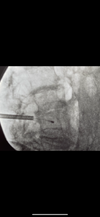- Joined
- Mar 3, 2012
- Messages
- 783
- Reaction score
- 547
- Points
- 5,276
- Medical Student
Honestly, I think the image was better on the computer where I took this from, and it didn't look as good off the crappy xray machine, but that could be me making excuses hah.
Rep is newer and I haven't seen attending do S1 TF over the year so I think overall inexperience with sacral stuff.
Appreciate all the feedback
Rep is newer and I haven't seen attending do S1 TF over the year so I think overall inexperience with sacral stuff.
Appreciate all the feedback

















